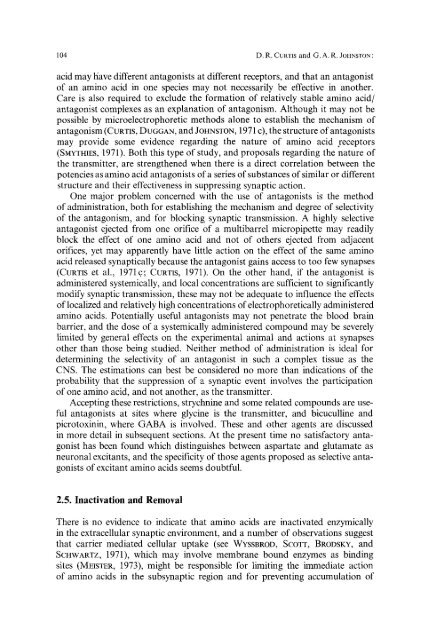Amino acid transmitters in the mammalian central nervous system
Amino acid transmitters in the mammalian central nervous system
Amino acid transmitters in the mammalian central nervous system
Create successful ePaper yourself
Turn your PDF publications into a flip-book with our unique Google optimized e-Paper software.
104 D.R. CURTIS and G. A. R. JOHNSTON :<br />
<strong>acid</strong> may 1/ave different antagonists at different receptors, and that an antagonist<br />
of an am<strong>in</strong>o <strong>acid</strong> <strong>in</strong> one species may not necessarily be effective <strong>in</strong> ano<strong>the</strong>r.<br />
Care is also required to exclude <strong>the</strong> formation of relatively stable am<strong>in</strong>o <strong>acid</strong>/<br />
antagonist complexes as an explanation of antagonism. Although it may not be<br />
possible by microelectrophoretic methods alone to establish <strong>the</strong> mechanism of<br />
antagonism (CURTIS, DUGGAN, and JOHNSTON, 1971 c), <strong>the</strong> structure of antagonists<br />
may provide some evidence regard<strong>in</strong>g <strong>the</strong> nature of am<strong>in</strong>o <strong>acid</strong> receptors<br />
(SMYTHIES, 1971). Both this type of study, and proposals regard<strong>in</strong>g <strong>the</strong> nature of<br />
<strong>the</strong> transmitter, are streng<strong>the</strong>ned when <strong>the</strong>re is a direct correlation between <strong>the</strong><br />
potencies as am<strong>in</strong>o <strong>acid</strong> antagonists of a series of substances of similar or different<br />
structure and <strong>the</strong>ir effectiveness <strong>in</strong> suppress<strong>in</strong>g synaptic action.<br />
One major problem concerned with <strong>the</strong> use of antagonists is <strong>the</strong> method<br />
of adm<strong>in</strong>istration, both for establish<strong>in</strong>g <strong>the</strong> mechanism and degree of selectivity<br />
of <strong>the</strong> antagonism, and for block<strong>in</strong>g synaptic transmission. A highly selective<br />
antagonist ejected from one orifice of a multibarrel micropipette may readily<br />
block <strong>the</strong> effect of one am<strong>in</strong>o <strong>acid</strong> and not of o<strong>the</strong>rs ejected from adjacent<br />
orifices, yet may apparently have little action on <strong>the</strong> effect of <strong>the</strong> same am<strong>in</strong>o<br />
<strong>acid</strong> released synaptically because <strong>the</strong> antagonist ga<strong>in</strong>s access to too few synapses<br />
(CURTIS et al., 1971c; CURTIS, 1971). On <strong>the</strong> o<strong>the</strong>r hand, if <strong>the</strong> antagonist is<br />
adm<strong>in</strong>istered <strong>system</strong>ically, and local concentrations are sufficient to significantly<br />
modify synaptic transmission, <strong>the</strong>se may not be adequate to <strong>in</strong>fluence <strong>the</strong> effects<br />
of localized and relatively high concentrations of electrophoretically adm<strong>in</strong>istered<br />
am<strong>in</strong>o <strong>acid</strong>s. Potentially useful antagonists may not penetrate <strong>the</strong> blood bra<strong>in</strong><br />
barrier, and <strong>the</strong> dose of a <strong>system</strong>ically adm<strong>in</strong>istered compound may be severely<br />
limited by general effects on <strong>the</strong> experimental animal and actions at synapses<br />
o<strong>the</strong>r than those be<strong>in</strong>g studied. Nei<strong>the</strong>r method of adm<strong>in</strong>istration is ideal for<br />
determ<strong>in</strong><strong>in</strong>g <strong>the</strong> selectivity of an antagonist <strong>in</strong> such a complex tissue as <strong>the</strong><br />
CNS. The estimations can best be considered no more than <strong>in</strong>dications of <strong>the</strong><br />
probability that <strong>the</strong> suppression of a synaptic event <strong>in</strong>volves <strong>the</strong> participation<br />
of one am<strong>in</strong>o <strong>acid</strong>, and not ano<strong>the</strong>r, as <strong>the</strong> transmitter.<br />
Accept<strong>in</strong>g <strong>the</strong>se restrictions, strychn<strong>in</strong>e and some related compounds are useful<br />
antagonists at sites where glyc<strong>in</strong>e is <strong>the</strong> transmitter, and bicucull<strong>in</strong>e and<br />
picrotox<strong>in</strong><strong>in</strong>, where GABA is <strong>in</strong>volved. These and o<strong>the</strong>r agents are discussed<br />
<strong>in</strong> more detail <strong>in</strong> subsequent sections. At <strong>the</strong> present time no satisfactory antagonist<br />
has been found which dist<strong>in</strong>guishes between aspartate and glutamate as<br />
neuronal excitants, and <strong>the</strong> specificity of those agents proposed as selective antagonists<br />
of excitant am<strong>in</strong>o <strong>acid</strong>s seems doubtful.<br />
2.5. Inactivation and Removal<br />
There is no evidence to <strong>in</strong>dicate that am<strong>in</strong>o <strong>acid</strong>s are <strong>in</strong>activated enzymically<br />
<strong>in</strong> <strong>the</strong> extracellular synaptic environment, and a number of observations suggest<br />
that carrier mediated cellular uptake (see WYSSBROD, SCOTT, BRODSKY, and<br />
SCHWARTZ, 1971), which may <strong>in</strong>volve membrane bound enzymes as b<strong>in</strong>d<strong>in</strong>g<br />
sites (MEISTER, 1973), might be responsible for limit<strong>in</strong>g <strong>the</strong> immediate action<br />
of am<strong>in</strong>o <strong>acid</strong>s <strong>in</strong> <strong>the</strong> subsynaptic region and for prevent<strong>in</strong>g accumulation of













